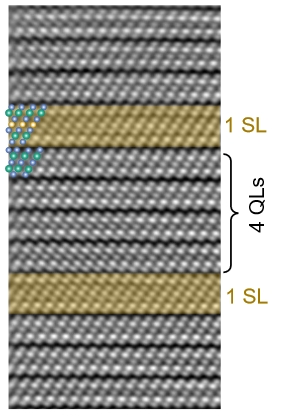Sep
9
New Material Insulates And Near Superconducts Electricity
September 9, 2020 | Leave a Comment
The finding, detailed in a paper published in Nature Physics, could be the basis of research leading to new, better energy efficient electrical conductors.

Atomically resolved STEM on a high magnification scale. The atomic positions of Bi (green), Te(blue), and Mn (yellow) in the SL and QL are indicated. Image Credit: Stony Brook University. Click image for the largest view.
The material is created and developed in a laboratory chamber. Over time atoms attach to it and the material appears to grow – similar to the way rock candy is formed. Surprisingly, it forms a novel ordered superlattice, which the researchers test for quantized electrical transport.
The research centers around the Quantum Anomalous Hall Effect (QAHE), which describes an insulator that conducts dissipationless current in discrete channels on its surfaces. Because QAHE current does not lose energy as it travels, it is similar to a superconducting current and has the potential if industrialized to improve energy-efficient technologies.
Cano, Assistant Professor in the Department of Physics and Astronomy in the College of Arts and Sciences at Stony Brook University and also an Affiliate Associate Research Scientist at the Flatiron Institute’s Center for Computational Quantum Physics said, “The main advance of this work is a higher temperature QAHE in a superlattice, and we show that this superlattice is highly tunable through electron irradiation and thermal vacancy distribution, thus presenting a tunable and more robust platform for the QAHE.”
Cano and colleagues said they can advance this platform to other topological magnets. The ultimate goal would be to help transform future quantum electronics with the material.
The collaborative research is being led by City College of New York under the direction of Lia Krusin-Elbaum, PhD.
To review in simpler terms, the material is an insulator. Except that its surface can be made to form conduction paths, something like a semiconductor does in today’s technology building computer processors and memory chips. “Conductor” suggest wires, but there isn’t a suggestion here for transmissions lines or motor windings.
Those big data centers consume lots of power. Semiconductors generate significant heat while operating. This technology may someday cut that energy requirement in a huge way. Still, the technology has a very long way to go.
The news is the Quantum Anomalous Hall Effect can be made to work and work well. The research is a step into a new field now. Where this could take technologies that can take advantage is anybody’s guess now.

